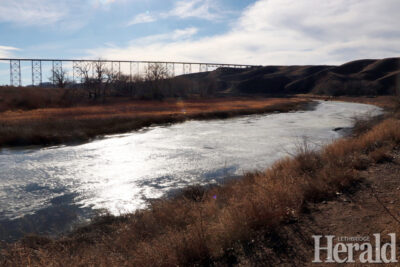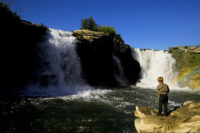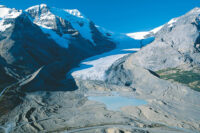Wetlands play crucial role in managing drought risk
By Steffanie Costigan - Lethbridge Herald Local Journalism Initiative Reporter on February 1, 2024.
 Herald photo by Steffanie Costigan
Sunshine reflects off the melting ice surface Wednesday at the Elizabeth Hall Wetlands in the city's river valley. Wetlands are needed in Alberta to help manage the risk of droughts, says the Nature Conservancy of Canada.
Herald photo by Steffanie Costigan
Sunshine reflects off the melting ice surface Wednesday at the Elizabeth Hall Wetlands in the city's river valley. Wetlands are needed in Alberta to help manage the risk of droughts, says the Nature Conservancy of Canada.The Nature Conservancy of Canada says wetlands are needed in Alberta to help manage the risk of drought.
Alberta Environment and Protected Areas recently shared a presentation highlighting actions the Alberta Government would be taking to assist in the expected drought for 2024.
The agenda addressed the current water situation, drought risk, and drought management.
Nature Conservancy of Canada communications coordinator Sean Feagan said wetlands in Alberta play a part in managing drought risk.
“Wetlands have different characteristics, things like vegetation, water depths, that sort of thing. We live in a really wetland-rich part of the country, part of the continent. And those wetlands provide us many benefits. Those can range from storing carbon, providing habitat, and one of the most important things is their ability to store water,” said Feagan.
Feagan said the focus of Nature Conservancy of Canada is on conserving wetlands within the ecosystem to mitigate droughts within Alberta.
“Our focus is on conserving land. How that fits in with the drought is the role that conservation plays within various ecosystem services, including things like the role of wetlands in flood and drought mitigation,” he said.
Feagan noted 64 per cent of wetlands within the settled areas of Alberta have been lost or impacted.
“That’s why conserving what we still have is so important,” noted Feagan. He explained how wetlands work in helping store water or moderate water during floods.
In Alberta, the NCC has completed 56 wetlands projects which have conserved 183,921 acres which store almost 31.8 million tonnes of carbon.
“In terms of floods, they can absorb excess water. And in terms of drought, they can supply water to surrounding surface water as well as groundwater. So they really kind of moderate kind of the hydrological state of things.”
The Alberta Environment and Protected Areas presentation for drought management can be viewed on YouTube at https://www.youtube.com/watch?v=hrFSNVre8as.
Feagan said two efforts are currently being made to preserve wetlands within Alberta.
“There’s kind of two efforts, there’s wetland conservation, so keeping the wetlands that exist on the landscape, and then there’s also wetland restoration. So that would be to create wetlands, usually in places where they have been destroyed,” he said.
According to Wetland Atlas of Alberta website under section 2.1, wetlands cover 21.7 per cent of Alberta.
Fen, also as known as muskeg, is the most common wetlands, covering 12.0 per cent, followed by open water habitat at 3.5 per cent, swamps at 2.7 per cent, bogs at 1.8 per cent, and marsh at 1.6 per cent.
Feagan expressed his hope more snowfall will add more water to the wetland storage.
“Hopefully we get a lot of snowfall, we get a lot of rain in the spring, and, you know, the wetlands out there on the landscape can help retain some of that water. And that that will lead to the recovery of these drought conditions,” he said.
Feagan said preserving and adding more wetlands can make Alberta more resilient when droughts come.
“What I would say is a landscape with more wetlands is a more resilient landscape.”
Friday is World Wetlands Day. According to Nature Conservancy Canada, “Canada is home to one quarter of the world’s wetlands. Bogs, peatlands, marshes, rivers, lakes, deltas, floodplains and flooded forests cover 15 per cent of our country’s landmass, and we are failing to protect these places. An estimated 70 per cent of southern Canada’s wetlands have been lost: paved over, ploughed through or otherwise destroyed. That figure rises to a nearly 95 per cent loss near densely populated areas.”
Every time a wetland is converted or degraded, the environmental benefits of these ecosystems provide is destroyed. Those benefits include water filtration, carbon storage, and the protection of nearby communities from spring melts and summer droughts. They also provide a home to hundreds of species of plants and animals.
Wetlands “absorb and hold water around our cities and farms, acting as buffers from floods and droughts. Coastal wetlands dampen storm surges by absorbing the wave energy and abating shore erosion. During heavy rains, these giant sponges hold water and release it gradually. Wetlands also provide natural fire breaks, which is incredibly important when considering the wildfires we’ve recently experienced across Canada,” says NCC.
“Like landscape-sized water treatment plants, they store and filter the water that we depend on. Their intricate plant life filters out sediment and excess nutrients from the water we use to make our coffee, brush our teeth and quench our thirst.”
So far, NCC has ensured the future of 415,137 acres of wetlands on 924 properties across Canada, which together store 87 million tonnes of carbon. This amount is equivalent to the emissions from more than 97 million passenger vehicles, almost 136 billion litres of gasoline or the amount of electricity used by 213 million homes in a year.
26-25





yes, i used to see the last vestiges of wetlands here in and around lethbridge. but the ugly cartel that calls itself developers has destroyed it all with strip malls, housing sprawls, and of course, the concrete and asphalt that comes with all of that. yay – we grow our population! yay – those at the top of the money pyramid get wealthier!